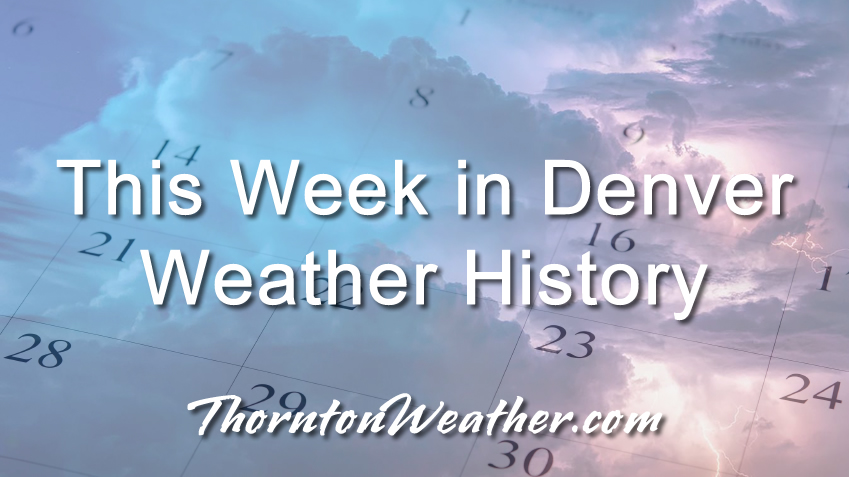
Snow in July? Officially no however, it was on July 17, 1872 that a U.S. Army Signal Service weather observer reported snow in Denver. However since official record-keeping did not begin until 1882, it doesn’t count. Read more about that event and others from this week in Denver weather history below.
From the National Weather Service:
1-18
In 1874…a streak of 18 consecutive days of 90 degrees tied for second with another streak that was later set in the summer of 1901. The record of 24 consecutive days was established in the summer of 2008.
1-31
In 2012…it was the hottest July on record in Denver since weather records began in 1872. The average temperature for the month was 78.9 degrees which was 4.7 degrees above normal. There were 27 days in which the high temperature equaled or exceeded 90 degrees…which established a new record. There were also 7 days in which the temperature equaled or exceeded 100 degrees which tied the record set in 2005.
6-23
In 1901…a streak of 18 consecutive days of 90 degrees tied for second with another streak set in the summer of 1874. The record of 24 consecutive days was established in the summer of 2008.
7-25
In 1934…a streak of 15 consecutive days of 90 degrees ranked 5th on the list of hot streaks. The record of 24 consecutive days was established in the summer of 2008.
13
In 1902…west winds were sustained to 42 mph with gusts to 48 mph.
In 1910…an apparent dry microburst produced northeast winds sustained to 41 mph.
In 1961…hail as large as 1 inch in diameter was reported near Commerce City.
In 1982…a tornado touched down briefly south of Parker. No damage was reported.
In 1985…thunderstorms drenched the Highlands Ranch area of northern Douglas County with 1.50 inches of rain in just 30 minutes. Half an inch of rain fell in 15 minutes in Littleton.
In 1986…a lightning bolt struck a church steeple in Littleton…toppling it to the ground.
In 1989…thunderstorm winds blew down trees and bent a metal basketball fixture just north of Castle Rock in the surrey ridge area.
In 1993…1 inch diameter hail was measured in Lakewood.
In 1995…lightning struck and injured an assistant coach during a baseball game at Highlands Ranch south of Denver.
In 1996…3/4 inch diameter hail fell in Lochbuie with 1 1/2 inch hail measured in Brighton. Thunderstorm winds gusted to 69 mph at Bennett. The strong winds were responsible for flipping three semi-trailer trucks onto their sides along I-70…3 miles east of Bennett. A few cars were also overturned.
In 2001…heavy thunderstorm rain caused flash flooding over south metro Denver. Three inches of rain reportedly fell near the greenwood village police department in the span of 15 minutes. The heavy rain caused toll gate creek to overflow…flooding low lying areas along Parker road. Heavy rainfall also caused local flooding along streets near the Denver technology center. A severe thunderstorm dumped hail to 1 3/4 inches in diameter near Castle Rock.
In 2003…maximum temperature of 100 degrees was a record high for the date.
In 2009…severe thunderstorms produced wind gusts to 70 mph near Parker and Strasburg. At Denver International Airport…west-northwest winds gusted to 40 mph.
In 2011…severe thunderstorms produced extensive damage as they moved across the urban corridor. At Denver International Airport alone…large hail up to golfball size…very heavy rain and wind gusts to 59 mph caused substantial damage to 40 planes and stranded approximately 1500 passengers overnight. Frontier and United airlines were hardest hit as dozens of planes were taken out of service for repairs; forcing the cancellation of at least 220 flights over the next several days. Damage to the aircrafts alone was nearly five million dollars. In addition…83 cars in airport parking lots were damaged… Along with some police cars and maintenance vehicles. In Watkins…two people suffered minor injuries and 35 to 40 homes were damaged. As many as two hundred residents in a mobile home park were left homeless by the storm…forcing the red cross to open a shelter at Bennett high school. The trailer park contained 52 mobile homes…14 recreational vehicles…3 houses and a commercial building. Hailstones the size of softballs cratered the north sides of the mobile homes. Some farmers in the area said they lost as much as 85 percent of their total wheat crop. Power lines were also damaged which affected about 1200 customers in Watkins. The strong winds also flipped over a tractor- trailer rig on I-70 near Watkins Road. Insurance claims for the Watkins…Bennett and Brighton areas was estimated to be seventeen million dollars. The total damage estimate across the entire urban corridor…was near one hundred sixty five million dollars…and included 17200 automobile claims and 12600 homeowner claims. In addition…thunderstorms producing very heavy rainfall…caused flash flooding in the Four Mile Canyon burn scar west of Boulder. Three homes reportedly had water up to the windows with water flowing into structures at Fourmile Canyon road and gold run road. The heavy rain caused a 4-ft surge along Fourmile Creek through Orodell and into the entry of Boulder Creek. Several roads were affected which restricted access to the area. Roads were closed due to water and debris. Private bridges and drives were washed out and several residents were stranded and later rescued. Numerous cars were damaged in debris flows and several structures suffered flood damage but were not destroyed.
In 2019…a severe thunderstorm produced hail up to 1.0 inch in diameter in Broomfield…with 7/8 inch size hail reported in Arapahoe County near Buckley AFB.
13-5
In 2008…a streak of 24 consecutive days of 90 degrees shattered the previous record of 18 consecutive days established in 1901 and 1874. Ironically…no new single day record high temperatures were set in the month of July. In August however…a record of 104 degrees was set on the 1st…and another record of 103 degrees was set on the 2nd. In addition…a record low min of 70 degrees was set on August 2nd.
14
In 1878…the temperature reached a high of 100 degrees in downtown Denver.
In 1906…a thunderstorm produced north winds sustained to 52 mph and 0.53 inch of rain in 10 minutes.
In 1912…a heavy thunderstorm cloudburst in the late afternoon combined with a similar storm to the south of the city to produce widespread flooding on Cherry Creek in downtown Denver…which resulted in two deaths and several injuries. The flooding was the worst since 1864 and covered around 3 square miles of lower downtown. Bridges along Cherry Creek were washed out and water lapped at the floor of the Broadway bridge over the South Platte River…causing authorities to declare it unsafe except for pedestrians. By nightfall… Union Depot was under 2 to 3 feet of water…and railroad and street car traffic was stalled. Those forced from their homes by the surging flood waters took refuge in the Denver auditorium. The flood waters caused great damage to the sewerage system…parkways…bridges and residences and commercial warehouses near Cherry Creek in the wholesale district. Flood damage was estimated at several million dollars. Heavy thunderstorm rainfall of 2.00 inches…of which nearly 1.75 inch fell in 30 minutes in central Denver… Was accompanied by severe thunderstorm winds sustained to 55 mph with gusts as high as 74 mph.
In 1933…thunderstorm rainfall was only 0.01 inch…but northwest winds sustained to 37 mph with gusts to 47 mph produced a dust storm for about 10 minutes during the late afternoon.
In 1967…heavy rain flooded areas of north and west metro Denver…and high water closed street intersections in the city. Crops were damaged…and 200 chickens drowned by flooding northwest of Denver where farm buildings and irrigation facilities were also damaged.
In 1969…a thunderstorm wind gust to 51 mph was recorded at Stapleton International Airport.
In 1975…heavy rains caused locally heavy flash flooding along Niver Creek south of Thornton and in other parts of north metro Denver. Over 40 thousand dollars in damage to public property was reported…and numerous homes and yards were damaged.
In 1986…thunderstorm winds blew down a power line in west- central Jefferson County. The storm…as it moved into Denver…snapped tree limbs and damaged a fence near Washington Park. Wind gusts in the area were estimated at 80 to 85 mph.
In 1990…thunderstorm wind gusts to 58 mph were recorded at Buckley Field in Aurora. No damage was reported. Winds gusted to 44 mph at Stapleton International Airport.
In 1993…a severe thunderstorm moved across southern sections of metro Denver. Dime size hail fell in Lakewood…and hail up to one inch diameter was measured at Cheery Creek Reservoir. Later in the afternoon…hail to one inch diameter fell in Golden and Arvada.
In 1994…hail to 1 1/4 inches in diameter fell north of Bennett.
In 1998…dry microburst winds estimated to 70 mph snapped tree branches up to 4 inches in diameter in Brighton where some road signs were twisted and blown down. At Denver International Airport…dry microburst winds gusted to 61 mph.
In 1995…thunderstorm winds gusted to 62 mph near Strasburg.
In 2001…a severe thunderstorm dumped hail to 3/4 inch in diameter in the foothills about 10 miles northwest of Golden.
In 2011…severe thunderstorms in the Denver metropolitan area produced very heavy rain…large hail and damaging winds. The strong winds toppled a few trees and the heavy rain caused street flooding and minor flash flooding. Several cars were stranded at the intersection of Santa Fe Drive and Oxford…and near Broadway and U.S. Highway 285. A 16-yr old teenager was seriously injured when he tried to retrieve a ball along the banks of West Toll Gate Creek. He was pulled from the swollen creek and died several days later. Hail up to one inch in diameter was reported around the area. The thunderstorms also produced frequent lightning. One strike sparked a fire at aspen academy…a private school in Greenwood Village. Most of the damage was confined to the roof and attic. In Englewood…a 40-ft tree was blown into a house and knocked down some power lines. At Denver International Airport…a severe thunderstorm produced sustained winds of 47 mph and a peak wind gust to 68 mph.
In 2019…a Denver man was killed and his wife injured after he was struck by lightning when they were hiking near the Bear Peak West Ridge Trail. The man was likely hit from a direct lightning strike to his upper body. His wife was not directly hit…but injured by the electrical current from the strike that hit her husband.
14-15
In 1985…thunderstorms dumped heavy rain and hail at numerous locations along the Front Range from Denver north. Some of the heaviest rain fell in northern and western suburbs of Denver. Up to 2.6 inches of rain drenched Arvada…and Thornton was soaked with 2 inches in 45 minutes. At least 5 homes in Arvada suffered extensive damage from water and mud…and many streets and basements were flooded. In southern Jefferson County…11 homes were struck by lightning.
Continue reading July 13 to July 19: This Week in Denver Weather History →





























































































































